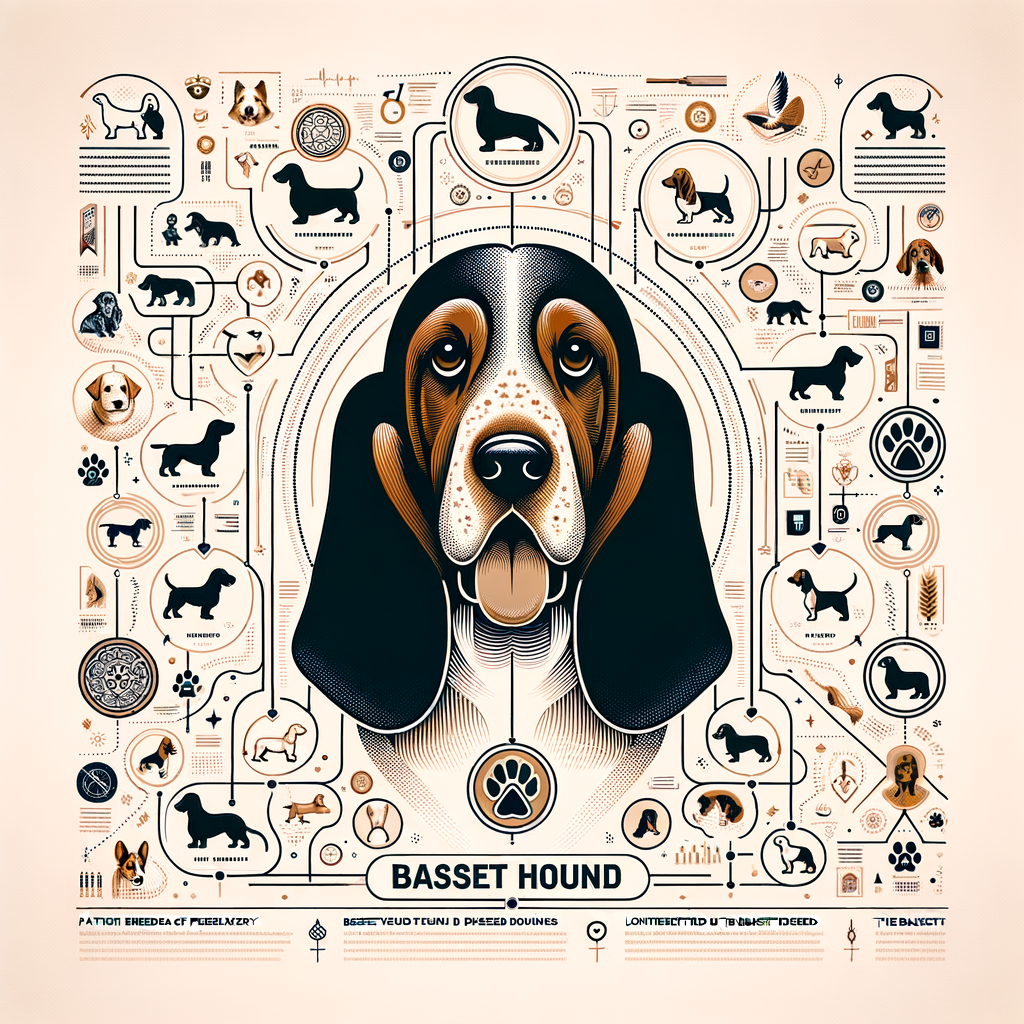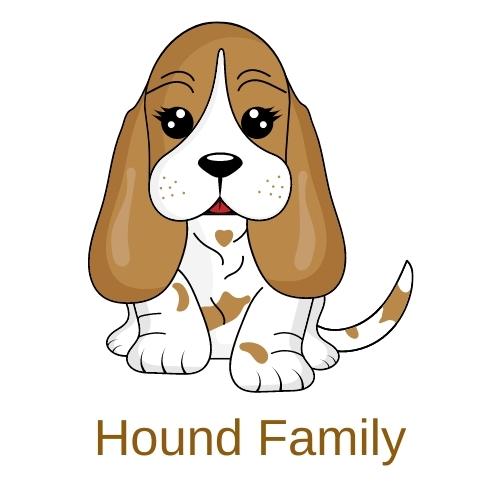
Introduction to Basset Hound Breed History
As we embark on this journey to understand the rich history of the Basset Hound breed, it’s important to note that this breed’s lineage is as unique as its appearance. The Basset Hound’s history is intertwined with the evolution of dog breeding practices, societal changes, and even the course of human history itself.
- Overview of the Basset Hound breed
- Importance of understanding Basset Hound lineage
The Basset Hound is a short-legged breed of dog belonging to the hound family. They are renowned for their keen sense of smell, second only to the Bloodhound. Basset Hounds are easily recognizable by their long, droopy ears and mournful eyes. Despite their somewhat gloomy appearance, Basset Hounds are friendly, outgoing, and excellent with children and other pets. They were originally bred for hunting small game, but today, they are mostly kept as family pets.
Understanding the lineage of the Basset Hound is crucial for several reasons. Firstly, it provides insights into the breed’s unique characteristics and behaviors. For instance, their exceptional sense of smell can be traced back to their hunting ancestry. Secondly, knowledge of a breed’s history helps in responsible breeding practices, ensuring the health and longevity of the breed. Lastly, it fosters a deeper appreciation and respect for the breed, enhancing the bond between the owner and the pet.
As we delve deeper into the Basset Hound’s history, we will uncover fascinating facts about their origins, ancestry, and genetics. This knowledge will not only enrich our understanding of this remarkable breed but also help us appreciate the Basset Hound’s rich history.
Origin of Basset Hound
The Basset Hound, a breed known for its distinctive appearance and keen sense of smell, has a rich history that dates back hundreds of years. Let’s delve into the historical background of the Basset Hound breed and explore how its geographical origin influenced its development.
- Historical Background of the Basset Hound Breed
- Geographical Origin and Its Influence on the Breed
The Basset Hound is believed to have originated in France during the 16th century. The breed’s name comes from the French word ‘bas’, which means ‘low’. This is a fitting description for the Basset Hound, which is known for its short, sturdy legs and long body.
Originally, Basset Hounds were bred for hunting small game, such as rabbits and hares. Their excellent sense of smell, second only to the Bloodhound, made them exceptional tracking dogs. They were also valued for their ability to follow a scent trail without the need for human guidance.
The Basset Hound’s development was heavily influenced by its geographical origin. The breed was developed in France, a country known for its diverse landscapes. The Basset Hound’s short legs and sturdy body made it well-suited for navigating through dense underbrush and uneven terrain, which are common in many parts of France.
Furthermore, the Basset Hound’s long ears, which drag on the ground as it sniffs, help to stir up and retain scent particles. This trait would have been especially useful in the French countryside, where the breed was often used to track game.
In conclusion, the Basset Hound’s unique physical characteristics and exceptional scent-tracking abilities can be traced back to its historical and geographical origins. This breed, which was developed for hunting in the diverse landscapes of France, continues to be cherished for its distinctive appearance and keen sense of smell.
Basset Hound Ancestry
The Basset Hound, a breed known for its distinctive appearance and charming personality, has a rich ancestry. The breed’s history is a fascinating blend of various dog breeds, each contributing unique traits and characteristics.
Breeds Contributing to Basset Hound
Understanding the Basset Hound’s ancestry requires a look at the parent breeds that contributed to its development. Let’s delve into the identification of these breeds and their roles in shaping the Basset Hound’s genetics.
- Identification of Parent Breeds
- Role of Each Parent Breed in Basset Hound Genetics
The Basset Hound is believed to have descended from the St. Hubert’s Hound, a breed that originated in Belgium. Other contributing breeds include the Bloodhound and the Basset Artesien Normand, a French breed known for its short legs and long ears – traits that are now synonymous with the Basset Hound.
Each parent breed has played a significant role in shaping the Basset Hound’s genetics. The St. Hubert’s Hound contributed to the Basset’s keen sense of smell, second only to the Bloodhound. The Bloodhound’s influence is seen in the Basset’s droopy eyes and long ears. The Basset Artesien Normand, on the other hand, is responsible for the Basset Hound’s short stature and distinctive body shape.
These breeds have collectively contributed to the Basset Hound’s unique physical characteristics and temperament, making it a beloved pet and a popular choice for families worldwide.
| Parent Breed | Contributions to Basset Hound Genetics |
|---|---|
| St. Hubert’s Hound | Keen sense of smell |
| Bloodhound | Droopy eyes and long ears |
| Basset Artesien Normand | Short stature and distinctive body shape |
In conclusion, the Basset Hound’s ancestry is a rich tapestry of various breeds, each leaving its mark on the Basset’s distinctive appearance and exceptional scent-tracking abilities.
Basset Hound Genetics
Understanding the genetics of Basset Hounds can help us appreciate their unique characteristics and potential health concerns. Let’s delve into the key genetic traits of these adorable dogs and how genetics influence their behavior and health.
- Key genetic traits of Basset Hounds
- Short Legs: The Basset Hound’s short legs are due to a genetic condition known as chondrodysplasia, which affects the development of their bones and cartilage.
- Long Ears: Their long, droopy ears are not just for show. They help stir up scent particles, aiding their exceptional sense of smell.
- Loose Skin: The loose skin around their face and neck helps to trap scent particles, further enhancing their tracking abilities.
- How genetics influence Basset Hound behavior and health
- Behavior: Basset Hounds are genetically predisposed to be excellent scent trackers. They are known for their stubbornness, which can be attributed to their breeding as independent hunters.
- Health: Unfortunately, Basset Hounds are prone to certain genetic health issues. These include hip and elbow dysplasia, obesity, and ear infections due to their long, droopy ears.
Basset Hounds are known for their distinctive physical features. These traits are a result of their unique genetic makeup. Here are some of the key genetic traits of Basset Hounds:
Genetics not only determine the physical traits of Basset Hounds but also influence their behavior and health. Let’s explore how:
In conclusion, the genetics of Basset Hounds play a significant role in their physical traits, behavior, and health. Understanding these can help us provide better care and appreciation for these lovable dogs.
Basset Hound Heritage and Pedigree
The heritage and pedigree of a Basset Hound are crucial aspects that contribute to their unique characteristics. Let’s delve into these aspects to better understand this breed.
- Understanding Basset Hound Pedigree
- Significance of Heritage in Breed Characteristics
The pedigree of a Basset Hound is a documented lineage that traces back to the breed’s origin. This pedigree is a testament to the breed’s purity and is often used by breeders to maintain the breed’s distinctive traits. For instance, the Basset Hound’s long ears and short legs are traits that have been preserved through careful breeding.
Understanding a Basset Hound’s pedigree can provide valuable insights into their potential health and behavior. For example, a pedigree can reveal if a Basset Hound’s ancestors had any health issues, which could potentially be passed down to future generations.
The heritage of a Basset Hound plays a significant role in shaping the breed’s characteristics. Originating from France, Basset Hounds were bred for hunting small game. Their keen sense of smell, second only to the Bloodhound, and their short stature, which allows them to stay close to the ground, are traits that have been preserved due to their hunting heritage.
Furthermore, their heritage also influences their temperament. Basset Hounds are known for their gentle and friendly nature, making them excellent companions. Their heritage as hunting dogs also means they are intelligent and trainable, but their independent streak can sometimes make them stubborn.
| Characteristic | Explanation |
|---|---|
| Long Ears | Helps in trapping scents close to the nose |
| Short Legs | Keeps them close to the ground to pick up scents |
| Keen Sense of Smell | Second only to the Bloodhound, useful for tracking |
| Gentle Temperament | Makes them great companions |
| Intelligence | Reflects their heritage as hunting dogs |
In conclusion, understanding the heritage and pedigree of a Basset Hound can provide valuable insights into their characteristics and potential health. It’s a testament to their rich history and the careful breeding that has preserved their distinctive traits.
Basset Hound Breed Information
The Basset Hound is a distinctive breed, known for its unique physical characteristics and friendly temperament. Let’s delve into the details of this breed’s features and behavior.
- Physical characteristics of Basset Hounds
- Behavioral traits and temperament
Basset Hounds are easily recognizable due to their distinctive physical features. They are medium-sized dogs, typically weighing between 40 to 65 pounds. Their bodies are long and low to the ground, with short legs and a muscular build. The most striking features of Basset Hounds are their large, droopy ears and expressive eyes. Their coat is short and smooth, and it can come in a variety of colors, including tri-color, black and white, and lemon and white.
| Physical Feature | Description |
|---|---|
| Size | Medium |
| Weight | 40-65 pounds |
| Coat | Short and smooth |
| Colors | Tri-color, black and white, lemon and white |
Basset Hounds are known for their friendly and patient temperament. They are excellent family pets, getting along well with children and other animals. Despite their somewhat sad-looking expression, Basset Hounds are actually quite playful and outgoing. They are also known for their loyalty and can be quite protective of their family. However, they can be stubborn at times, which can make training a bit of a challenge. But with patience and consistency, they can be taught to follow commands.
In conclusion, Basset Hounds are a unique breed with a lot to offer. Their distinctive physical characteristics and friendly temperament make them a beloved choice for many families.
Basset Hound Parent Breeds
Understanding the parent breeds of the Basset Hound is crucial for appreciating the unique characteristics of this breed. Let’s dive into the details.
- Identifying the Parent Breeds
- How Parent Breeds Influence Basset Hound Traits
The Basset Hound is a descendant of two prominent breeds, namely the Bloodhound and the Basset Artesien Normand. The Bloodhound is known for its exceptional sense of smell and tracking ability, while the Basset Artesien Normand is admired for its low build and strong body.
| Parent Breed | Key Characteristics |
|---|---|
| Bloodhound | Exceptional sense of smell, excellent tracking ability |
| Basset Artesien Normand | Low build, strong body |
The Basset Hound inherits its distinctive traits from its parent breeds. From the Bloodhound, it gets its remarkable sense of smell, second only to the Bloodhound itself. This makes the Basset Hound an excellent tracker. From the Basset Artesien Normand, it inherits its short legs and strong body, which give it a unique appearance and sturdy build.
These inherited traits make the Basset Hound a breed that is both charming and functional. Its keen sense of smell and tracking abilities make it a valuable working dog, while its unique appearance and friendly temperament make it a beloved family pet.
Conclusion: Appreciating the Basset Hound’s Rich History
As we draw to a close, it’s essential to reflect on the rich history of the Basset Hound breed. This understanding allows us to appreciate these dogs more and provides us with insights into their unique traits and behaviors.
- Recap of Basset Hound breed history
- The value of understanding your Basset Hound’s ancestry
The Basset Hound, with its roots in France, is a breed with a history as rich as its personality. These dogs were initially bred for hunting, specifically for their excellent scent-tracking abilities. Their unique physical characteristics, such as their long ears and short legs, were all developed to aid in their hunting prowess. Over the years, Basset Hounds have evolved from being hunting companions to beloved family pets, known for their gentle demeanor and loyalty.
Understanding the history of your Basset Hound’s breed is more than just an interesting fact. It can provide valuable insights into their behavior, health, and care needs. For instance, knowing that Basset Hounds were bred for hunting can explain their keen sense of smell and their tendency to follow scents. This knowledge can help you provide a more enriching environment for your Basset Hound, catering to their instinctual needs.
In conclusion, the Basset Hound is a breed with a rich history and unique characteristics that make them stand out. By understanding their history and ancestry, we can better appreciate these wonderful dogs and provide them with the care and environment they need to thrive.







